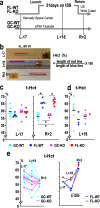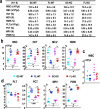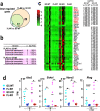Nrf2 alleviates spaceflight-induced immunosuppression and thrombotic microangiopathy in mice
- PMID: 37626149
- PMCID: PMC10457343
- DOI: 10.1038/s42003-023-05251-w
Nrf2 alleviates spaceflight-induced immunosuppression and thrombotic microangiopathy in mice
Abstract
Spaceflight-related stresses impact health via various body systems, including the haematopoietic and immune systems, with effects ranging from moderate alterations of homoeostasis to serious illness. Oxidative stress appears to be involved in these changes, and the transcription factor Nrf2, which regulates expression of a set of cytoprotective and antioxidative stress response genes, has been implicated in the response to spaceflight-induced stresses. Here, we show through analyses of mice from the MHU-3 project, in which Nrf2-knockout mice travelled in space for 31 days, that mice lacking Nrf2 suffer more seriously from spaceflight-induced immunosuppression than wild-type mice. We discovered that a one-month spaceflight-triggered the expression of tissue inflammatory marker genes in wild-type mice, an effect that was even more pronounced in the absence of Nrf2. Concomitant with induction of inflammatory conditions, the consumption of coagulation-fibrinolytic factors and platelets was elevated by spaceflight and further accelerated by Nrf2 deficiency. These results highlight that Nrf2 mitigates spaceflight-induced inflammation, subsequent immunosuppression, and thrombotic microangiopathy. These observations reveal a new strategy to relieve health problems encountered during spaceflight.
© 2023. Springer Nature Limited.
Conflict of interest statement
The authors declare no competing interests.
Figures










References
-
- Shavers MR, et al. Implementation of ALARA radiation protection on the ISS through polyethylene shielding augmentation of the Service Module Crew Quarters. Adv. Space Res. 2004;34:1333–1337. - PubMed
-
- Tharmalingam S, Sreetharan S, Kulesza AV, Boreham DR, Tai TC. Low-dose ionizing radiation exposure, oxidative stress and epigenetic programing of health and disease. Radiat. Res. 2017;188:525–538. - PubMed
-
- Rodrigues-Moreira S, et al. Low-dose irradiation promotes persistent oxidative stress and decreases self-renewal in hematopoietic stem cells. Cell Rep. 2017;20:3199–3211. - PubMed
-
- Sies H, et al. Defining roles of specific reactive oxygen species (ROS) in cell biology and physiology. Nat. Rev. Mol. Cell Biol. 2022;23:499–515. - PubMed
Publication types
MeSH terms
Substances
LinkOut - more resources
Full Text Sources
Molecular Biology Databases

